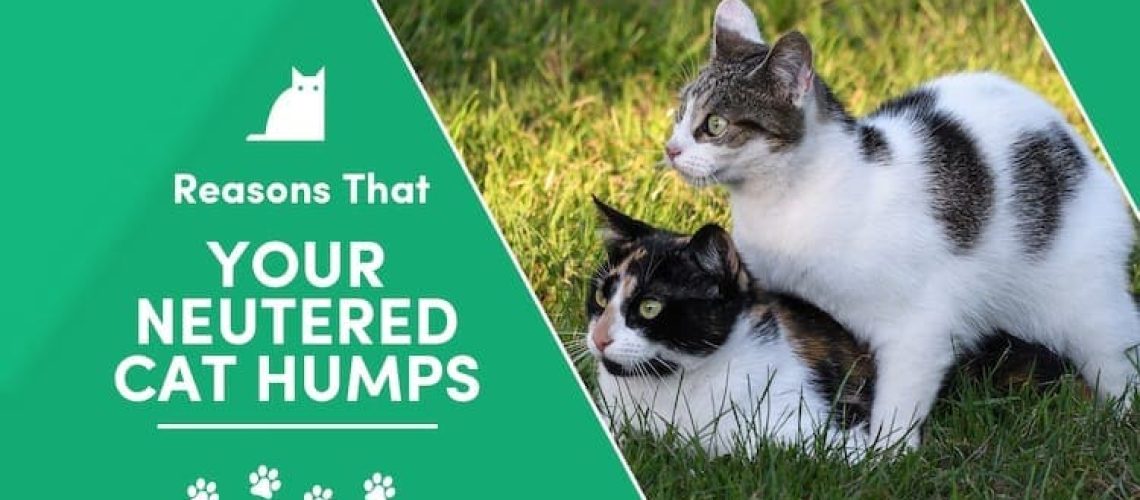Have you ever wondered why neutered cats still exhibit humping behavior? It's a puzzling phenomenon that has left cat owners scratching their heads. But fear not, because delving into this topic can provide valuable insights into your feline friend's behavior. Understanding why neutered cats engage in this seemingly strange behavior is essential for creating a harmonious environment for both you and your pet. So, let's unravel the mounting mysteries of why neutered cats still hump and uncover the secrets behind their puzzling actions. Get ready to embark on a fascinating journey into the world of feline behavior!
Key Takeaways:
- Neutering does not always eliminate the instinctual behavior of humping in cats.
- Some neutered cats may continue to hump objects or other animals due to learned behaviors or underlying medical issues.
- Humping can be a sign of dominance, stress, or anxiety in neutered cats.
- Providing appropriate outlets for play and mental stimulation can help redirect humping behaviors in neutered cats.
- If excessive humping persists, it is recommended to consult with a veterinarian to rule out any potential medical causes.
Unraveling the Mystery: Why Do Neutered Cats Still Hump?
The Curious Behavior of Neutered Cats
Have you ever noticed your neutered cat engaging in a strange behavior called humping? It may surprise you to see this behavior, especially since neutering is supposed to eliminate sexual behaviors in cats. So why do some neutered cats still hump? It's a mystery that many cat owners want to unravel.
When a male cat is neutered, it means that his testicles are surgically removed. This procedure is done to prevent unwanted pregnancies and reduce certain behaviors associated with mating, such as spraying urine or aggression. However, even after being neutered, some male cats continue to exhibit humping behavior.
Possible Reasons for Humping Behavior
- Hormonal Influence: While neutering removes the main source of testosterone production in male cats, it doesn't eliminate all hormones. Some residual hormones may still be present, which can influence their behavior.
- Learned Behavior: Cats are observant creatures and can learn behaviors from other cats or humans. If a neutered cat sees another cat humping or receives attention when they engage in the behavior, they may imitate it as a way to seek attention.
- Stress or Anxiety: Like humans, cats can experience stress and anxiety. Humping may serve as a coping mechanism for these emotions. If your cat is experiencing changes in their environment or routine, it could trigger this behavior.
Understanding the possible reasons behind humping behavior in neutered cats can help us better care for our feline friends and provide them with the support they need.
Exploring the Reasons Behind Humping Behavior in Neutered Cats
Unraveling the Mystery of Humping
If you've ever witnessed your neutered cat humping, you might have wondered why they engage in this behavior. While it may seem perplexing, there are several reasons that could explain why neutered cats still hump.
One possible reason is that some male cats may continue to produce small amounts of testosterone even after being neutered. Testosterone is a hormone responsible for sexual behaviors, and its presence can influence a cat's urge to hump. Although the levels are significantly reduced after neutering, it's possible for residual hormones to affect their behavior.
Another reason could be learned behavior. Cats are intelligent animals that learn by observing others. If a neutered cat sees another cat or even a human engaging in humping behavior, they may imitate it as a way to seek attention or simply because they find it pleasurable.
Tips to Manage Humping Behavior
- Provide Distractions: Engage your cat in playtime with interactive toys or provide scratching posts to redirect their energy and focus away from humping.
- Create a Calming Environment: Ensure your cat has a safe and stress-free environment by providing hiding spots, comfortable bedding, and vertical spaces for them to explore.
- Consult with a Veterinarian: If the humping behavior becomes excessive or causes distress, consult with a veterinarian who can evaluate your cat's overall health and provide further guidance.
By exploring the reasons behind humping behavior in neutered cats and implementing strategies to manage it, we can better understand our feline companions and ensure their well-being.
Fascinating Stories of Neutered Cats and Their Mysterious Humping Habits
Curious Cases of Neutered Cats
Have you ever wondered why neutered cats sometimes engage in humping behavior? It's a puzzling mystery that has left many cat owners scratching their heads. Let me share with you some fascinating stories of neutered cats and their mysterious humping habits.
One such story involves a neutered male cat named Whiskers. Whiskers had been neutered at a young age, but as he grew older, he developed a peculiar habit of humping stuffed animals. His owner, Mrs. Johnson, was initially perplexed by this behavior. She couldn't understand why her sweet and affectionate cat would engage in such an unusual activity.
Another intriguing case is that of Luna, a spayed female cat who would occasionally mount other cats in the household. This behavior puzzled her owner, Mr. Smith, as Luna had been spayed early on and there were no intact males around to trigger this behavior.
These stories highlight the enigmatic nature of neutered cats' humping habits. While it may seem strange or even comical to us humans, it's important to remember that these behaviors have underlying reasons that we need to explore further.
The Role of Hormones
One possible explanation for these behaviors lies in the residual effects of hormones on neutered cats. Even after being spayed or neutered, some cats may still experience hormonal fluctuations that can influence their behavior.
When a cat is neutered or spayed, their reproductive organs are removed, but certain hormone-producing glands remain intact. These glands can continue to produce small amounts of hormones that may affect the cat's behavior.
In some cases, these residual hormones can cause mounting or humping behaviors in neutered cats. It's important to note that these behaviors are not driven by sexual desire but rather by instinct or other factors.
Understanding the role of hormones in neutered cats' humping habits is just one piece of the puzzle. Let's explore more possible explanations to shed light on this intriguing behavior.
Possible Explanations for Why Neutered Cats Engage in Humping Behavior
Instinctual Behaviors and Territory Marking
While hormones may play a role, there are other factors that can contribute to humping behavior in neutered cats. One such factor is instinctual behavior and territory marking.
Cats, even when neutered, have natural instincts that drive their behavior. Humping can be a way for them to assert dominance or establish their territory. By engaging in this behavior, they may be sending a message to other cats or animals in the household.
Additionally, humping can also be a form of stress relief for some cats. Just like humans engage in certain behaviors when feeling anxious or stressed, cats may resort to humping as a coping mechanism.
It's important for cat owners to understand that humping behavior in neutered cats is not necessarily abnormal or problematic. However, if it becomes excessive or causes distress to the cat or other household members, it may be necessary to intervene and find ways to manage or prevent it.
Managing Humping Behavior
If you're a cat owner dealing with humping behavior from your neutered cat, there are several strategies you can try:
1. Provide appropriate outlets for energy: Make sure your cat has plenty of toys and opportunities for playtime. Engaging them in interactive play sessions can help redirect their energy towards more appropriate activities.
2. Create a calm environment: Reduce stressors in your cat's environment by providing a quiet and comfortable space for them. This can help alleviate anxiety and reduce the likelihood of humping behavior.
3. Consult with a veterinarian: If the humping behavior persists or becomes problematic, it's always a good idea to consult with a veterinarian. They can rule out any underlying medical conditions and provide guidance on managing the behavior.
By understanding the possible explanations for neutered cats' humping habits and implementing appropriate strategies, cat owners can ensure their pets' well-being and create a harmonious living environment.
How Understanding Mounting Mysteries Helps Cat Owners Care for Their Pets
The Importance of Education
As a cat owner, it's crucial to educate yourself about your pet's behaviors and needs. Understanding mounting mysteries, such as neutered cats' humping habits, can help you provide better care for your furry friend.
When you have knowledge about why certain behaviors occur, you can respond appropriately and address any potential issues that may arise. By being proactive in your approach to caring for your cat, you can prevent problems from escalating and ensure their overall well-being.
Building Stronger Bonds
Furthermore, understanding these mysteries can strengthen the bond between you and your cat. By recognizing their instincts and unique behaviors, you'll be able to communicate more effectively with them.
Cats rely on us to meet their physical and emotional needs. When we understand their behaviors, we can better fulfill those needs and create a deeper connection with our feline companions.
So take the time to dive deep into the subject of neutered cats' mysterious behaviors. Your efforts will not only benefit your own pet but also contribute to the wider community of cat owners and animal lovers.
Tips and Strategies to Manage or Prevent Humping Behavior in Neutered Cats
Redirecting Their Energy
If you're looking for ways to manage or prevent humping behavior in your neutered cat, here are some tips and strategies that can help:
- Provide plenty of interactive toys and playtime opportunities to redirect their energy towards more appropriate activities.
- Consider using puzzle feeders or treat-dispensing toys to mentally stimulate your cat and keep them engaged.
- Create a routine that includes regular play sessions to ensure your cat gets enough exercise and mental stimulation.
Environmental Enrichment
Another effective strategy is to enrich your cat's environment. Here are some ideas:
- Set up scratching posts and vertical spaces for climbing to fulfill their natural instincts.
- Offer different textures and materials for them to explore, such as cardboard boxes or soft blankets.
- Provide hiding spots or cozy beds where they can retreat when they need some alone time.
By implementing these tips and strategies, you can create a stimulating environment for your neutered cat, reducing the likelihood of humping behavior while promoting their overall well-being.
The Importance of Learning about Neutered Cats' Mysterious Behaviors for Cat Owners and Animal Lovers
A Deeper Understanding
Learning about the mysterious behaviors of neutered cats goes beyond mere curiosity. It allows us to gain a deeper understanding of our feline companions and the complex world they inhabit.
By delving into these mysteries, we become better equipped to provide the care and support our cats need. We can tailor our approach based on their individual needs, ensuring they live happy, fulfilled lives.
Advocating for Cats Everywhere
Furthermore, by sharing this knowledge with others, we can advocate for cats everywhere. Many cat owners may be unaware of the reasons behind their pets' behaviors and may resort to misguided or ineffective approaches.
By spreading accurate information and promoting understanding, we can help create a community of informed cat owners who prioritize their pets' well-being. Together, we can make a positive impact on the lives of countless cats.
So let's continue exploring the mysteries of neutered cats' behaviors, sharing our knowledge, and creating a world where all cats receive the love and care they deserve.
In conclusion, neutered cats may still hump due to various reasons like instinct or learned behaviors. While it can be puzzling, further research is needed to fully understand this behavior in order to provide the best care for our feline friends.

















